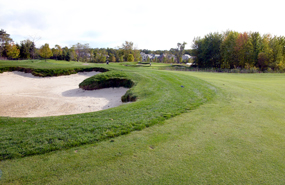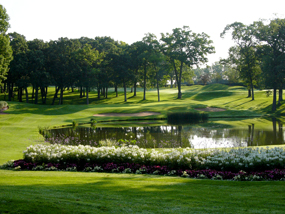GOLF COURSE CONSTRUCTION MANAGEMENT
AND TECHNIQUES
Craig Schreiner was a co-instructor of this vital 2-day GCSAA Seminar,
which was offered at the annual Golf Industry Show, for over fifteen years.
GOLF COURSE CHARACTER
AND LANDSCAPE PLANTING
The distinctive elements that comprise a golf course are formed from the
indigenous elements that make up the physiography. Vegetation, soils,
topography, water resources and exposure all combine to produce the 'genius
loci' or the 'spirit' of a site. The golf course has further dimension
in the elements that make it complete like the greens, fairways, tees,
bunkers and other hazards. The combination of all these elements in unison
work to create the 'character' of the course.
The playing characteristics and conditions are more of a deliberate management style and philosophy. The visual and physical characteristics of a course are a result of integrating the game of golf onto a physical site that is different from any other. Each site is truly different, at least slightly. However, similarities will be evident if courses are built in close proximity to each other. Physical conditions vary but not radically on most golf course sites.
Clubhouse locations all vary in size, location, style and function. The entrance and service areas are always somewhat unique. Residential communities are now frequently associated with most new courses. Classic style venues have a 'park like' appearance with mature trees almost covering all the roughs. New 'links' have emerged inland and on the coasts to emulate the classic architecture of the British Isles. Target golf was introduced to reduce the water usage demand in the desert climates that appeal to the winter migration and retirement settlements all throughout the southern portion of the US.
Defining the character of a course both visually and with respect to playing qualities is a process of identifying course management (strategies to scoring) and inventory work regarding the greens, bunkers fairways, tees, vegetation, exposure, wildlife habitat, soils and the maintained landscape. The combination of these natural and man-made elements forms the character of a golf course. Consistent but slight variations of these design elements create the variety and spectrum of the course. Each hole should have a slight similarity yet be different visually and with respect playing quality.
If the course has lost this contiguous quality, it is the task of the course professionals to restore or even develop this DNA fingerprint. This seminar attempts to inventory the individual holes and then find the common denominator that will add continuity and the subtle variety that is essential to developing a memorable and beautiful golf course.

Strategic location
of hazards and the 'risk and reward' potential
also play a role in the playing quality of a course. The closer a
shot skirts this fairway hazard, the more rewards are reaped
because the green receives shots better from this vantage.

Classic
courses have the look of a 'park' since they all received ample tree plantings
during the last fifty years. The desire to fill the space between many
holes was a goal of enthusiastic tree and beautification committees.
 Mature trees now clutter the air space of many courses. Proper tree management
is a tedious and politically unpopular undertaking
Mature trees now clutter the air space of many courses. Proper tree management
is a tedious and politically unpopular undertaking
 Plantings and decorative arrangements have found their way onto many golf
courses. The replication of specific visual treatments affects the character
of a golf course. Finding the 'balance' is critical to establishing the
course character.
Plantings and decorative arrangements have found their way onto many golf
courses. The replication of specific visual treatments affects the character
of a golf course. Finding the 'balance' is critical to establishing the
course character.

Bunkers, native areas,
fairway widths and greens set the tone for the visual and playing quality
of a golf course. The terrain is the primary element that responds to
gravity. Ball roll and run are influenced by how the holes fit into the
landscape.

